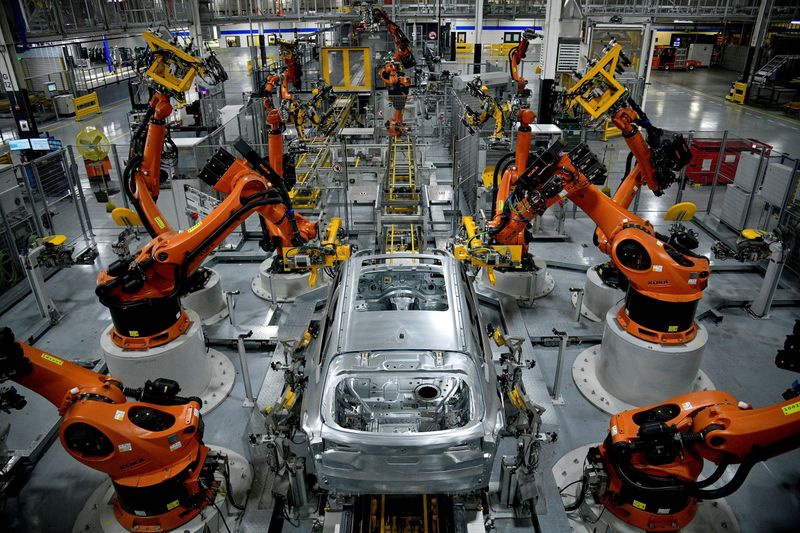By Lucia Mutikani
WASHINGTON (Reuters) - U.S. manufacturing activity picked up in May as pent-up demand amid a reopening economy boosted orders, but unfinished work piled up because of shortages of raw materials and labor.
The Institute for Supply Management (ISM) survey on Tuesday found companies and their suppliers "continue to struggle to meet increasing levels of demand," noting that "record-long lead times, wide-scale shortages of critical basic materials, rising commodities prices and difficulties in transporting products are continuing to affect all segments" of manufacturing.
According to the ISM, worker absenteeism and short-term shutdowns because of shortages of parts and workers continued to limit manufacturing's growth potential.
"Strong demand is a good problem to have, but that demand is increasingly straining manufacturers' ability to keep pace," said Jim Baird, chief investment officer at Plante Moran Financial Advisors in Kalamazoo, Michigan.
The ISM's index of national factory activity increased to a reading of 61.2 last month from 60.7 in April. A reading above 50 indicates expansion in manufacturing, which accounts for 11.9% of the U.S. economy. Economists polled by Reuters had forecast the index rising to 60.9 in May.
Graphic: ISM PMI - https://graphics.reuters.com/USA-STOCKS/qmypmzoaqvr/ismpmi.png
A shift in demand to goods from services as the COVID-19 pandemic kept Americans at home strained supply chains, with the virus also disrupting labor at manufacturers and their suppliers, leading to raw material shortages across industries.
More than half of adults in the United States are now fully vaccinated against COVID-19, allowing authorities to lift pandemic-related restrictions on businesses. That is whipping up demand across the economy, as is massive fiscal stimulus. There is no sign the supply bottlenecks are easing, even as demand is reverting back to services.
Sixteen manufacturing industries, including furniture, machinery, transportation equipment, computer and electronic products, and electrical equipment, appliances and components reported growth last month. Only the printing and related support activities industry reported a contraction.
In the computer and electronic products industry, manufacturers complained about poor supplier performance, adding that "demand is high, and we are struggling to find employees to help us keep up." Similar complaints were echoed across other industries. Food, beverage and tobacco products manufacturers said "delays at the port continue to strain inventory levels."
Makers of fabricated metal products reported they did not expect the supply chain constraints to improve "until possibly the fourth quarter of 2021 or beyond."
Supply challenges are likely holding back the construction sector, with spending on projects rising only 0.2% in April after surging 1.0% in March, a separate report from the Commerce Department showed.
Graphic: Construction spending - https://graphics.reuters.com/USA-STOCKS/bdwvkxdzkpm/constspend.png
U.S. stocks were trading higher, with the benchmark S&P 500 just shy of its record peak. The dollar fell against a basket of currencies. U.S Treasury prices were lower.
ONCE-IN-A-LIFETIME DEMAND BOOM
The survey's forward-looking new orders sub-index jumped to 67.0 from a reading of 64.3 in April. Inventories at factories are barely growing and business warehouses are almost empty.
A measure of factory employment dropped to a six-month low. According to the ISM, "an overwhelming majority" of companies are hiring or attempting to hire, "with more than 50% of them expressing difficulty in doing so."
Labor is scarce despite nearly 10 million Americans being officially unemployed. Generous unemployment benefits funded by the government, problems with child care and fears of contracting the virus, even with vaccines widely accessible, as well as pandemic-related retirements have been blamed for keeping workers home.
Lack of workers and shortages of raw materials such as semiconductors used in the production of motor vehicles and electronic goods led to a further increase in backlogs of uncompleted work.
Suppliers took much longer to deliver to manufacturers last month, with the supplier deliveries index jumping to 78.8. That was the highest reading since April 1974 and followed 75 in April. A reading above 50 suggests slower deliveries. With constraints mounting, production at factories grew at its slowest pace since last June.
"This has to be infuriating for factories seeing a once-in-a-lifetime demand surge but are unable to take full advantage of it for lack of parts," said Sarah House, a senior economist at Wells Fargo (NYSE:WFC) in Charlotte, North Carolina.
The shortages are also keeping input prices elevated, fanning inflation. The ISM survey's measure of prices paid by manufacturers hovered near levels last seen in July 2008, when the economy was in the throes of the Great Recession.
The government reported on Friday that a measure of underlying inflation tracked by the Federal Reserve for its 2% target accelerated 3.1% on a year-on-year basis in April, the biggest increase since July 1992.
Most economists and Fed Chair Jerome Powell maintain that higher inflation will be transitory.
There are concerns that persistently higher commodity prices could squeeze profit margins, though lower inventories give businesses ample pricing power. The slowdown in hiring at factories last month could temper expectations for an acceleration in job growth in May after nonfarm payrolls increased by only 266,000 in April.

According to an early Reuters survey of economists, payrolls likely increased by 664,000 jobs last month. The government is due to publish May's employment report on Friday.
"We doubt these labor supply constraints will ease significantly before September and could hold back payrolls growth again this Friday," said James Knightley, chief international economist at ING in New York.